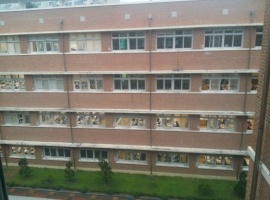Blog Archives
Chaos in the halls
The students sit. They listen somewhat attentively in class. Participate in activities. A few are whispering with friends, but most are paying attention. Then, the bell rings.
In its basic form, life in a Korean middle school is similar to that of an American one. While the classes are much more focused on memorization and recall than creativity or composition, the school buildings and basic curriculum look the same. However, what stands out as perplexing in this unique culture, one that focuses on saving “face” and polite personal relations, is the chaos that ensues at school between the bells.
A Korean school bell is not the sound of a “real” bell or a beep or an alarm; the sound resembles a music box. At the end of each 45 minute period, the sing-song jingle reverberates through the halls and classrooms (this one here, actually: http://seoulsounds.wordpress.com/2010/02/08/055-elementary-school-bell/). The bell signals 10 minutes of passing time…and the transformation of the school into a space of utter chaos.
Like schools in America and others abroad, the way that students behave ranges from perfect to those who fall asleep in class. Most teachers are relatively strict; corporal punishment is illegal in Korea, but many teachers still use physical punishments like push-ups or holding in plank position, so students are well-behaved when they have to be.
During break, even the most seemingly angelic students lose all inhibitions. It’s assumed that when class is over, teachers have no obligation to maintain order. The teachers retreat to their respective group offices and, to unaccustomed ears, a war begins. Doors slam, students run around the halls, there’s screaming, and mini-fights break out. In the classrooms themselves, students go on the computers and play K-Pop music videos on the projectors. There’s also a lot of physical horseplay, but teachers will step in if a real altercation occurs.
It is as if these 10 minute breaks are a way for students to exert a primal scream— recess taken to a whole new level. The break is a small escape from daily middle school life, a regiment which only gets more intense when students progress into high school. Nevertheless, every time there’s a break, I am still a little bit in shock.
As a foreigner, the most fascinating part of this small aspect of school culture is how it fits in with larger societal norms. Korea has a distinct set of rules for inter-personal relations and behavior. Etiquette matters. At first, the behavior that students show in between classes seems to clash with established expectations. Yet, the school behavior is arguably revealing of a larger cultural norm in the society. It’s not just that “saving face” and perceived politeness matter, it’s when it matters. The break reinforces the idea that students should be on their best behavior if someone is there to police them, but otherwise they should let loose. This is a universal aspect of human behavior and relations–people put on the correct persona for the situation. Most people don’t act the same way at a club or bar with friends as they do when speaking with their boss or co-workers at work. Korean Middle School magnifies this dichotomy to an extreme level.
I don’t seek to criticize the students’ behavior or the school for not stopping it. As an American, it’s just one more aspect of culture shock and something to get used to. As a teacher, it’s very confusing. How does one model good behavior for students, but expect them to only show it superficially? It makes me wonder: what kind of expectations do we set for students as teachers?
I suspect that the intense nature of the Korean school system is what partially drives the acting out, but that is most likely only one of many factors. Whatever the reason, Korean students on break display the best and worst parts of middle school…and the bell is about to ring.
